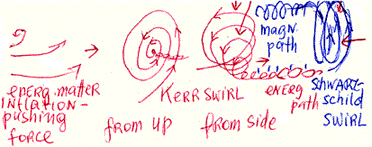Chapter 3 - Wave Theory and
Quarks
(Continued —
Page 8)
Printer-Friendly Version
The two loops in an energetic formation are in continuous
competition. The gravitational (perpendicular) loop tries
to maintain energy and the integrity of the wave. The energetic
loop, with its pushing and pulling properties, can either
disperse or maintain energy. Energetic paths near the centre
of the swirl are impossible to detach from one another. The
further they are from the centre, the weaker the paths’
forces. For this reason, these strong forces are in very condensed
spaces. The behaviour of energetic matter is inflationary;
its swirling propagation creates swirling, closed formations.
The forces pushing toward the inside of the swirl create a
singularity (picture to follow).

In a magnetic loop, the energetic paths face the inside of
the swirl, so that everything around the loop is attracted
to it. All objects that do not have enough  energy
to escape from its (so-called) gravity are pulled inward.
Every formation having internal energy can resist a pulling
object and avoid collapsing; escape, however, depends on the
distance from the pulling object and the strength of the formation’s
energetic loop (picture at right). energy
to escape from its (so-called) gravity are pulled inward.
Every formation having internal energy can resist a pulling
object and avoid collapsing; escape, however, depends on the
distance from the pulling object and the strength of the formation’s
energetic loop (picture at right).
Before the Big Bang, the universe reached the point in its
cycle in which its energetic matter had swirling and shrinking
properties. Ever since the “Big Bang”, the universe
has inflationary properties. This will be described in the
chapter about the universe.
Swirls create magnetic and energetic loops that are in continuous
competition with each other. The first swirl is a Kerr swirl.
From its singularity, it expels energetic  matter
and creates energetic paths, creating a second swirl and paths.
Depending on the position of paths and rings in the waves
and between the waves, pushing and pulling properties arise.
Energetic matter has only spin and inflation properties; all
other forces arise from the behaviour of constellations of
energetic matter. Each loop has some of the properties of
its opposite loop as well (picture to the right). matter
and creates energetic paths, creating a second swirl and paths.
Depending on the position of paths and rings in the waves
and between the waves, pushing and pulling properties arise.
Energetic matter has only spin and inflation properties; all
other forces arise from the behaviour of constellations of
energetic matter. Each loop has some of the properties of
its opposite loop as well (picture to the right).
Back to
Top
Dr. Chaim Tejman, Copyright©
2001. All rights reserved.
[Index]
[Introduction]
[Summary] [Wave
Formation] [Photons] [Gravitation]
[Time]
[Atoms] [Life]
[Cancer] [Fundamental
Force] [Gender/Why Sex?]
[Sexual Reproduction]
[Schrodinger & Heisenberg]
[Creation] [Supernova]
[Dark
Matter & Astronomy] [Speed
of Light] [Cloud Formations]
[Natural Disasters] [Global
Warming] [Thermodynamics]
[Backward Time] [Quantum
Mechanics] [Compton Effect]
[Equations] [Predictions]
[Academic Correspondences] [Contact]
[Links] [Mysteries] |